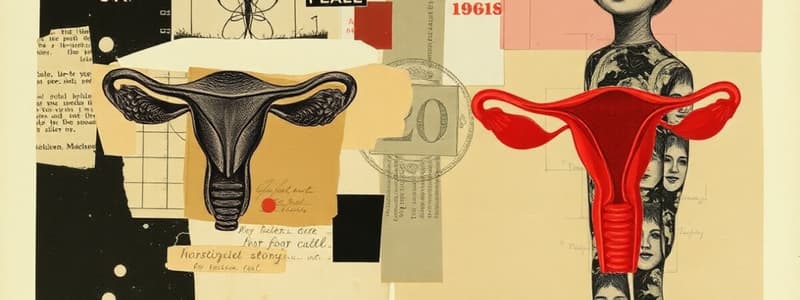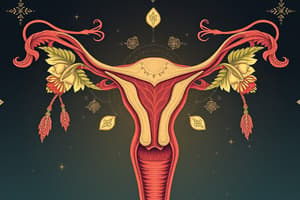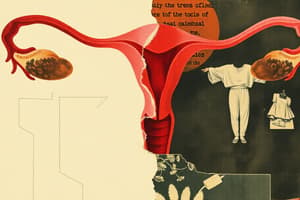Podcast
Questions and Answers
What primarily characterizes the follicular phase of the menstrual cycle?
What primarily characterizes the follicular phase of the menstrual cycle?
- Dominance of progesterone
- Luteinizing hormone predominance
- Reduction in uterine gland size
- Effect of oestrogens (correct)
What happens to the superficial parts of the endometrium just before menstruation?
What happens to the superficial parts of the endometrium just before menstruation?
- It thickens due to increased blood supply
- It experiences increased fluid content
- It becomes more vascularized for implantation
- It undergoes shedding due to cut-off blood supply (correct)
At what age does menstruation typically begin, a phenomenon known as menarche?
At what age does menstruation typically begin, a phenomenon known as menarche?
- 10 years
- 16 years
- 14 years
- 12 years (correct)
Which hormone primarily influences the changes during the luteal phase?
Which hormone primarily influences the changes during the luteal phase?
What is the primary external manifestation of the cyclic changes occurring in the uterus during the menstrual cycle?
What is the primary external manifestation of the cyclic changes occurring in the uterus during the menstrual cycle?
What is the outermost layer of the uterine wall called?
What is the outermost layer of the uterine wall called?
Which part of the uterus undergoes changes during the menstrual cycle?
Which part of the uterus undergoes changes during the menstrual cycle?
What type of glands are found within the stroma of the endometrium?
What type of glands are found within the stroma of the endometrium?
During the menstrual cycle, which arteries supply the entire thickness of the endometrium?
During the menstrual cycle, which arteries supply the entire thickness of the endometrium?
What is the primary function of the myometrium layer?
What is the primary function of the myometrium layer?
What phase of the menstrual cycle is primarily indicated by ovulation?
What phase of the menstrual cycle is primarily indicated by ovulation?
Which layer of the uterus is composed mainly of smooth muscle?
Which layer of the uterus is composed mainly of smooth muscle?
What type of epithelial cell is present during the postmenstrual phase?
What type of epithelial cell is present during the postmenstrual phase?
Which of the following statements about the arteries during the menstrual cycle is true?
Which of the following statements about the arteries during the menstrual cycle is true?
What change occurs to the epithelial cells at the end of the secretory phase?
What change occurs to the epithelial cells at the end of the secretory phase?
During which phase does glycogen accumulate in the basal portion of the epithelial cell?
During which phase does glycogen accumulate in the basal portion of the epithelial cell?
What happens to the lumen of the endometrium during the secretory phase?
What happens to the lumen of the endometrium during the secretory phase?
Which part of the endometrium does not participate in the changes associated with the menstrual cycle?
Which part of the endometrium does not participate in the changes associated with the menstrual cycle?
What is the primary function of the secretory activity of the uterine glands?
What is the primary function of the secretory activity of the uterine glands?
How does the arrangement of stromal cells change during the postmenstrual phase?
How does the arrangement of stromal cells change during the postmenstrual phase?
What is the characteristic of the endometrium at the end of the secretory phase?
What is the characteristic of the endometrium at the end of the secretory phase?
What primarily triggers the onset of menstrual bleeding?
What primarily triggers the onset of menstrual bleeding?
What happens to the thickened endometrium in the absence of pregnancy?
What happens to the thickened endometrium in the absence of pregnancy?
At the end of menstruation, what is the approximate thickness of the remaining endometrium?
At the end of menstruation, what is the approximate thickness of the remaining endometrium?
During the menstrual cycle, which phase involves the proliferation of cells in the basal parts of the uterine glands?
During the menstrual cycle, which phase involves the proliferation of cells in the basal parts of the uterine glands?
What occurs when the spiral arteries relax after becoming constricted?
What occurs when the spiral arteries relax after becoming constricted?
What does ischaemia of the endometrium specifically lead to?
What does ischaemia of the endometrium specifically lead to?
Which layers of the endometrium are primarily shed during menstrual bleeding?
Which layers of the endometrium are primarily shed during menstrual bleeding?
What component of the endometrium is responsible for rapid reforming of the epithelial lining after menstruation?
What component of the endometrium is responsible for rapid reforming of the epithelial lining after menstruation?
What is the overall function of the thickened endometrium during the menstrual cycle?
What is the overall function of the thickened endometrium during the menstrual cycle?
Flashcards
Menstrual Cycle
Menstrual Cycle
Cyclic changes in the endometrium (uterine lining) each month, including menstruation (blood flow).
Menstruation
Menstruation
The monthly shedding of the uterine lining.
Reproductive Period
Reproductive Period
The period of a woman's life when she can bear children.
Menarche
Menarche
Signup and view all the flashcards
Menopause
Menopause
Signup and view all the flashcards
Ovulation
Ovulation
Signup and view all the flashcards
Uterus Wall Layers
Uterus Wall Layers
Signup and view all the flashcards
Endometrium
Endometrium
Signup and view all the flashcards
Menstrual Cycle Phases
Menstrual Cycle Phases
Signup and view all the flashcards
Lining Epithelium
Lining Epithelium
Signup and view all the flashcards
Straight Artery
Straight Artery
Signup and view all the flashcards
Myometrium
Myometrium
Signup and view all the flashcards
Endometrial Gland Epithelium Change
Endometrial Gland Epithelium Change
Signup and view all the flashcards
Secretory Phase Cell Change
Secretory Phase Cell Change
Signup and view all the flashcards
Postmenstrual Phase Stroma
Postmenstrual Phase Stroma
Signup and view all the flashcards
Proliferative Phase Stroma
Proliferative Phase Stroma
Signup and view all the flashcards
Spiral Arteries Function
Spiral Arteries Function
Signup and view all the flashcards
Spiral Arteries Location
Spiral Arteries Location
Signup and view all the flashcards
Straight Arteries Location
Straight Arteries Location
Signup and view all the flashcards
Endometrium Thickness and Blood Supply
Endometrium Thickness and Blood Supply
Signup and view all the flashcards
Uterine Gland Secretion Benefit
Uterine Gland Secretion Benefit
Signup and view all the flashcards
Uterine Endometrium Regeneration
Uterine Endometrium Regeneration
Signup and view all the flashcards
Menstrual Bleeding Onset
Menstrual Bleeding Onset
Signup and view all the flashcards
Spiral Arteries
Spiral Arteries
Signup and view all the flashcards
Stratum Compactum
Stratum Compactum
Signup and view all the flashcards
Stratum Spongiosum
Stratum Spongiosum
Signup and view all the flashcards
Stratum Basale
Stratum Basale
Signup and view all the flashcards
Menstrual Shedding
Menstrual Shedding
Signup and view all the flashcards
Endometrial Proliferation
Endometrial Proliferation
Signup and view all the flashcards
Endometrial Regeneration
Endometrial Regeneration
Signup and view all the flashcards
Study Notes
The Menstrual Cycle
- The menstrual cycle refers to cyclical changes in the endometrium (lining of the uterus) occurring monthly.
- A key feature is menstruation, the monthly flow of blood.
- The cycle is divided into postmenstrual, proliferative, secretory, and menstrual phases.
- Another division is the follicular phase (estrogen-driven) and the luteal phase (progesterone-driven).
- Endometrial changes include increased thickness, uterine gland growth, changes in epithelial cells, and thickened stroma.
- Blood supply to superficial endometrial parts is cut off before menstruation, causing shedding and bleeding.
- The cycle is influenced by hormones like estrogen, progesterone, follicle-stimulating hormone (FSH), and luteinizing hormone (LH).
- The reproductive period is when a woman can bear children, marked by monthly menstruation (menses).
- Menarche is the onset of menstruation at around 12 years of age.
- Menopause is the cessation of menstruation around 45 years of age.
Phases of the Menstrual Cycle
- The cycle is typically divided into postmenstrual, proliferative, secretory (or premenstrual), and menstrual phases, based on endometrial changes.
- The follicular phase (first half) is characterized by actions of oestrogen from growing follicles, leading to endometrial changes.
- The luteal phase (second half) is controlled by progesterone from the corpus luteum, with significant endometrial changes.
Uterine Structure and Changes
- The uterus has three layers: perimetrium (outermost), myometrium (muscle), and endometrium (innermost).
- The endometrium is the layer undergoing cyclical changes during the menstrual cycle.
- The stroma (connective tissue) is found in the endometrium, and its structure varies in the different phases.
Hormonal Control of the Menstrual Cycle
- Gonadotropin-releasing hormone (GnRH) from the hypothalamus stimulates the anterior pituitary gland.
- The anterior pituitary releases follicle-stimulating hormone (FSH) and luteinizing hormone (LH), which affect the ovaries.
- FSH stimulates follicle growth and oestrogen production in the ovaries.
- LH triggers ovulation and corpus luteum formation, leading to progesterone production.
- Oestrogen and progesterone have significant effects on endometrial changes.
- The cycles are closely interconnected. LH surge leads to ovulation, and in response, the corpus luteum forms and secretes progesterone.
Clinical Correlation
- Understanding ovulation timing (e.g., using temperature charts) is pertinent for family planning.
- Contraceptive pills often contain synthetic hormones mimicking oestrogen and/or progesterone, preventing ovulation.
Studying That Suits You
Use AI to generate personalized quizzes and flashcards to suit your learning preferences.




